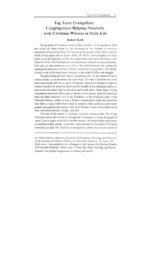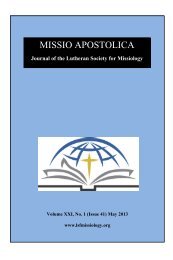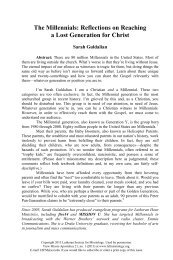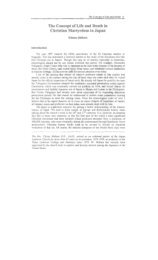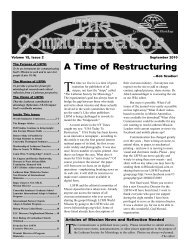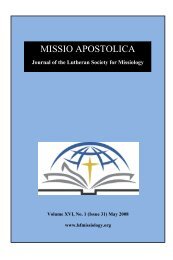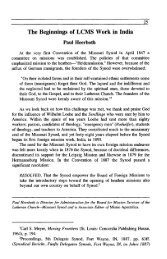Reflections of a New Missionary - Lutheran Society for Missiology
Reflections of a New Missionary - Lutheran Society for Missiology
Reflections of a New Missionary - Lutheran Society for Missiology
Create successful ePaper yourself
Turn your PDF publications into a flip-book with our unique Google optimized e-Paper software.
100 Missio Apostolica<br />
Who better to author this book than Dr. Andrew Hsiao, one among very few Chinese<br />
rightfully called "Mr. <strong>Lutheran</strong>" Born on the China mainland, but living most <strong>of</strong> his<br />
adult life in Hong Kong, Hsiao knows the Chinese <strong>Lutheran</strong> churchles as well as any<br />
person alive. He served as president <strong>of</strong> <strong>Lutheran</strong> Theological Seminary in Hong Kong <strong>for</strong><br />
some 24 years (1971-1995), where he still serves an active ministry as president<br />
emeritus. He also served as vice-president <strong>of</strong> the <strong>Lutheran</strong> World Federation, which<br />
deepened his acquaintance with Chinese churches outside Hong Kong. A few years ago,<br />
he wrote a multi-volume Chinese work, Understanding the <strong>Lutheran</strong> Church, which<br />
introduced the doctrines, history, ethos, and practices <strong>of</strong> the <strong>Lutheran</strong> Church. The<br />
present volume is an extension <strong>of</strong> the historical section <strong>of</strong> that work. In three brief<br />
chapters, Hsiao provides a reliable, current summary <strong>of</strong> <strong>Lutheran</strong> ministry in the Chinese<br />
world.<br />
In the <strong>for</strong>m <strong>of</strong> the eccentric Karl Giitzlaff and hls furtive attempts to enter China,<br />
<strong>Lutheran</strong> ministry in China can be said to have begun as early as 1831. In a more<br />
prolonged and institutional sense, <strong>Lutheran</strong> ministry began about 1850 with the coming<br />
<strong>of</strong> missionaries from three German mission societies.<br />
Over the coming century, upwards <strong>of</strong> a dozen other mission societies began ministry,<br />
many at the turn <strong>of</strong> the century, and others, including the LCMS, within another decade<br />
or so. By treating each <strong>of</strong> these in turn, in terms both <strong>of</strong> the founding mission agency and<br />
<strong>of</strong> the counterpart Chinese churches/synods, Hsiao brings order to a bewildering variety<br />
<strong>of</strong> agencies: Denmark (I), Finnish (I), German (4), Norway (3), Sweden (I), USA (5),<br />
mixed (1). His patient retelling <strong>of</strong> this history (the first chapter, approximately half <strong>of</strong> the<br />
book) documents remarkable dedication by <strong>Lutheran</strong> Churches to the task <strong>of</strong> mission in<br />
the face <strong>of</strong> difficult and recurring crises (natural disasters, overthrow <strong>of</strong> dynasty, <strong>for</strong>eign<br />
incursions, anti-<strong>for</strong>eign and anti-Christian movements, and civil war). One <strong>of</strong> the better<br />
kept secrets <strong>of</strong> the history <strong>of</strong> this era is the fact that by 1951 Chinese <strong>Lutheran</strong> churches<br />
had a membership upwards <strong>of</strong> 100,000, which represented more than 10% <strong>of</strong> the<br />
Protestant population at that time.<br />
One <strong>of</strong> Hsiao's sub-themes as he recounts this history is the story <strong>of</strong> the <strong>Lutheran</strong><br />
Church in China, founded in 1920. Begun as a <strong>for</strong>m <strong>of</strong> cooperative ministry (e.g.<br />
theological education, literature) by many diverse <strong>Lutheran</strong> societies, the LCC developed<br />
~nto a strong national church. Un<strong>for</strong>tunately, though the title <strong>of</strong> this chapter is "<strong>Lutheran</strong><br />
Churches in Mainland China," the account is focussed exclusively on the <strong>Lutheran</strong><br />
Church in China. This means that a non-LCC <strong>Lutheran</strong> church is not part <strong>of</strong> that story,<br />
e.g. the LCMS and its counterpart church. What bits and pieces <strong>of</strong> that history there are,<br />
appear only as historical background in the entry on the <strong>Lutheran</strong> Church-Hong Kong<br />
Synod.<br />
The second chapter <strong>of</strong> Hsiao's survey covers "Chinese <strong>Lutheran</strong> Churches outside<br />
Mainland China." The major part <strong>of</strong> this chapter presents the history and ministry<br />
(structure, evangelism, education, social services, theological education, church<br />
cooperation) <strong>of</strong> the seven <strong>Lutheran</strong> rnissions/synods in Hong Kong, the six major<br />
missionsisynods in Taiwan, and the two major missions/synods in Malaysia-Singapore.<br />
Much briefer word is given about Chinese churches in the Western world (Australia,<br />
Europe, and North America). This is a much more widely diverse history, difficult to pin



